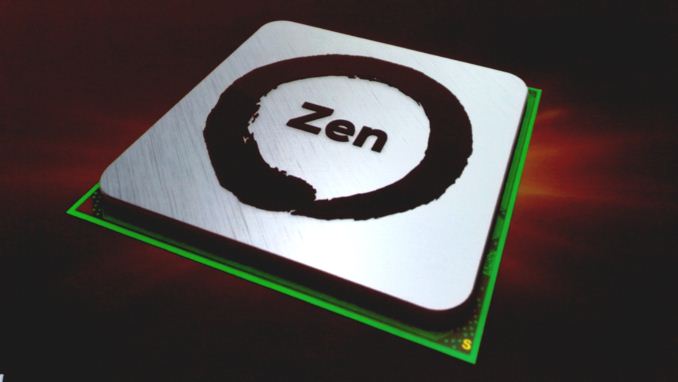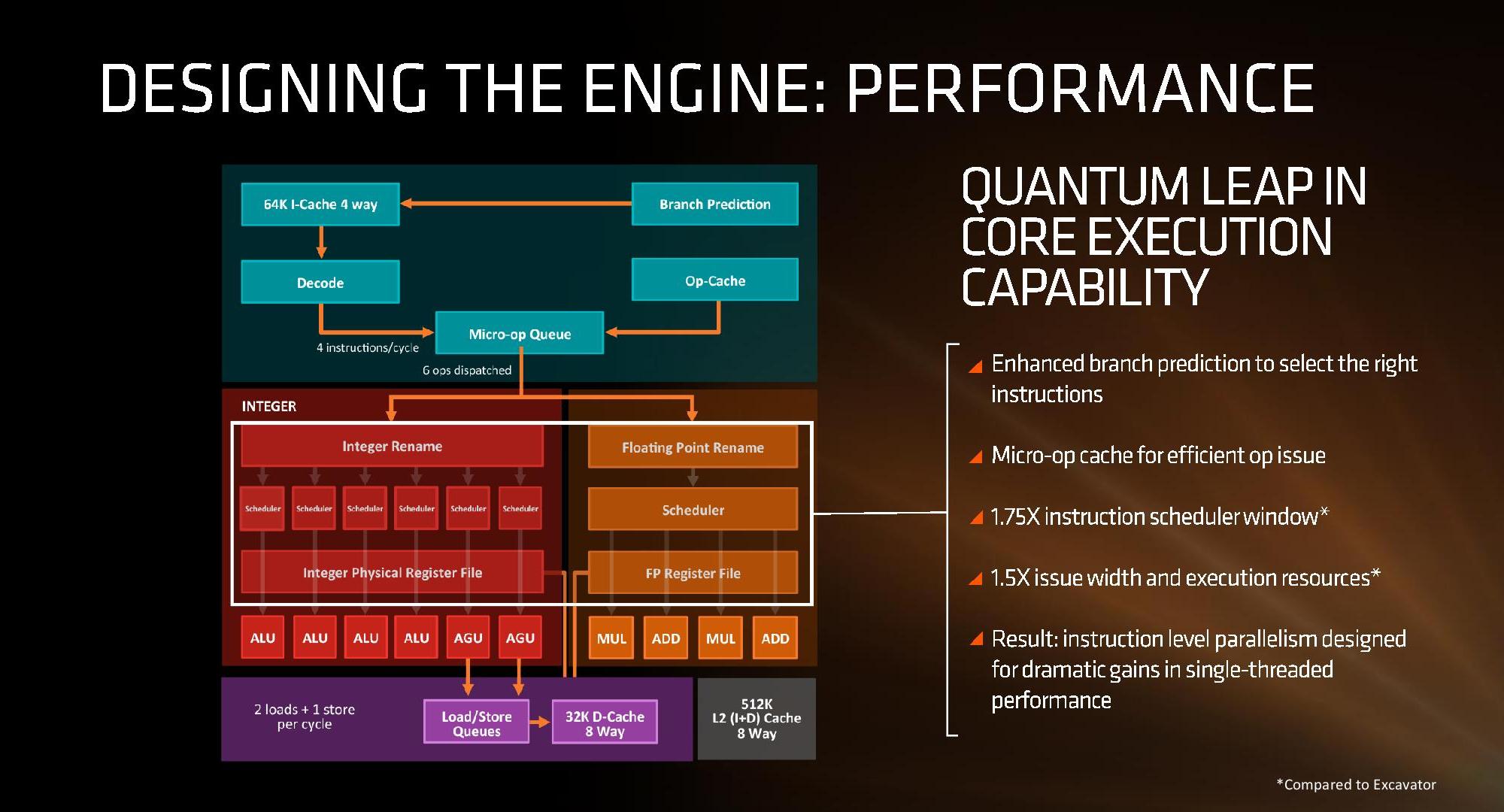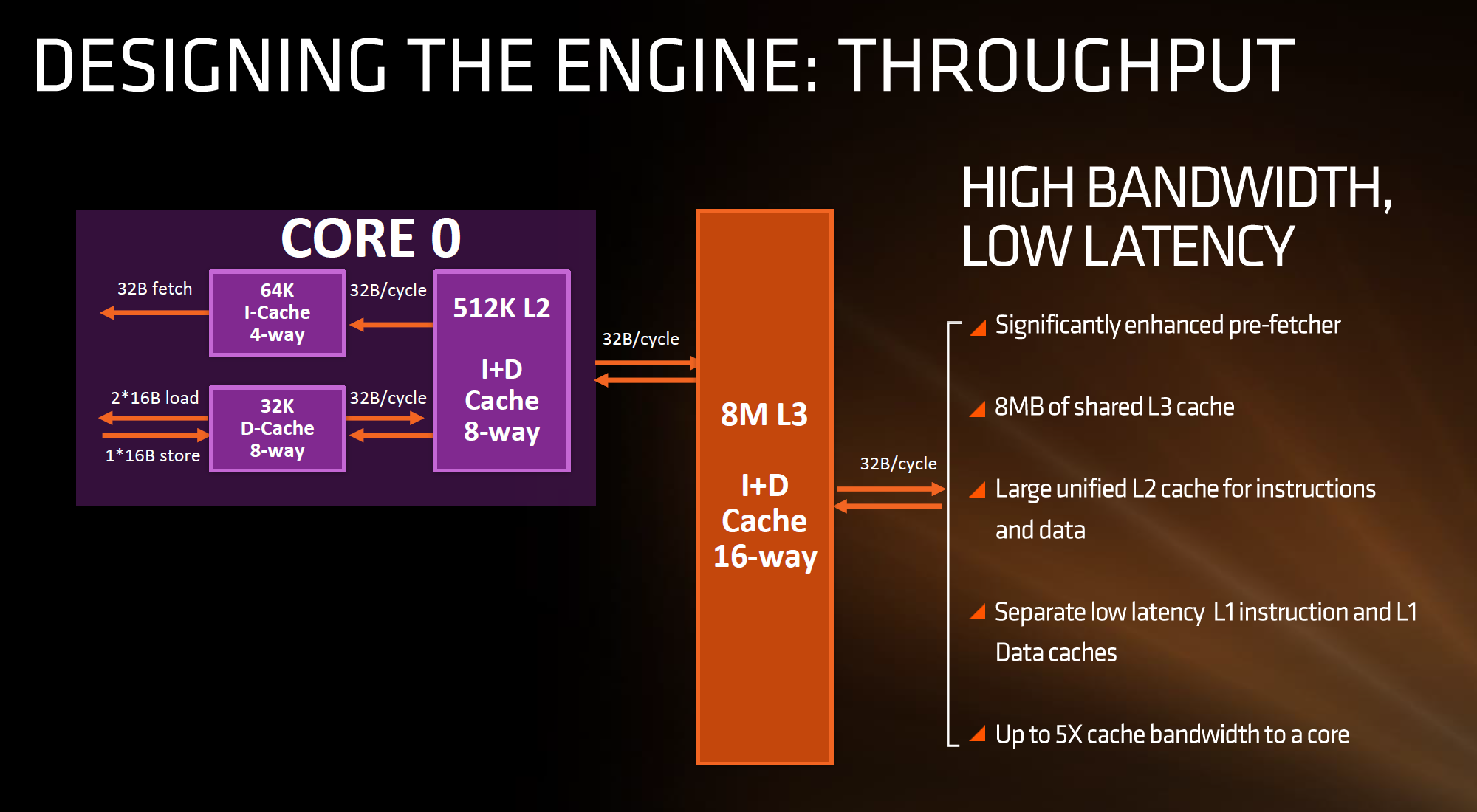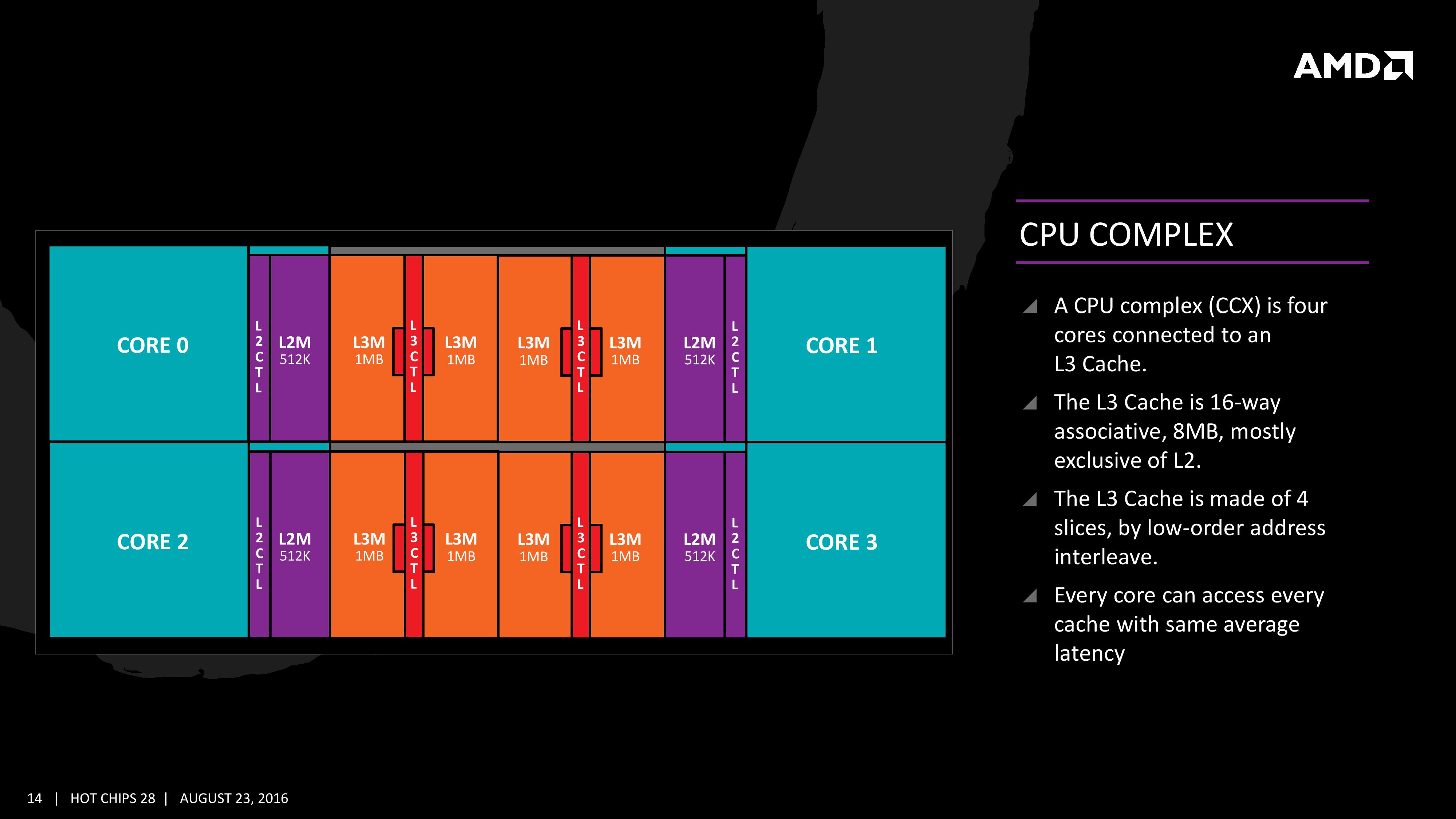AMD Zen Microarchiture Part 2: Extracting Instruction-Level Parallelism
by Ian Cutress on August 23, 2016 8:45 PM EST- Posted in
- CPUs
- AMD
- x86
- Zen
- Microarchitecture

Hot Chips is an annual conference that allows semiconductor companies to present their latest and greatest ideas or forthcoming products in an academic-style environment, and is predominantly aimed as the professional semiconductor engineer. This year has a number of talks about power management, upcoming IBM CPUs, upcoming Intel CPUs, upcoming NVIDIA SoCs and the final talk of the final day is from AMD, discussing Zen in even more depth than the previous week. While we were unable to attend the event in person, we managed to get some hands on time with information and put questions to Mike Clark, AMD Senior Fellow and design engineer.
What We Learned Last Week: L1/L2/L3 Caches and the Micro-Op Buffer
In AMD’s initial presentation for the general media, we were given a sense of the microarchitecture layout. We covered the material, but it contained a number of highlights.
AMD Zen Microarchitecture: Dual Schedulers, Micro-op Cache and Memory Hierarchy Revealed
AMD Server CPUs and Motherboard Analysis
Unpacking AMD's Zen Benchmark: Is Zen actually 2% Faster than Broadwell?
First up, and the most important, was the announcement of the inclusion of a micro-op cache. This allows for instructions that are frequently used to be closer to the micro-op queue and saves a trip through the core and caches to load the desired information. Typically micro-op caches are still relatively small, and while AMD isn’t giving any information for size and accessibility, we know that Intel’s version can support 1536 uOps with 8-way associativity; we expect AMD’s to be similar though there are many options in play.
Secondly is the cache structure. We were given details for the L1, L2 and L3 cache sizes, along with associativity, to compare it to former microarchitectures as well as Intel’s offering.
| CPU Cache Comparison | |||||
| Zen HEDT |
Bulldozer HEDT |
Excavator |
Skylake | Broadwell HEDT |
|
| L1-I | 64KB/core | 64KB/module | 96KB/module | 32KB/core | 32KB/core |
| 4-way | 2-way | 3-way | 8-way | 8-way | |
| L1-D | 32KB/core | 16KB/thread | 32KB/thread | 32KB/core | 32KB/core |
| 8-way | 4-way | 8-way | 8-way | 8-way | |
| L2 | 512KB/core | 1MB/thread | 512KB/thread | 256KB/core | 256KB/core |
| 8-way | 16-way | 16-way | 4-way | 8-way | |
| L3 | 2MB/core | 1MB/thread | - | >2MB/core | 1.5-3MB/core |
| 16-way | 64-way | - | 16-way | 16/20-way | |
| L3 Type | Victim | Victim | - | Write-back | Write-back |
In this case, AMD has given Zen a 64KB L1 Instruction cache per core with 4-way associativity, with a lop-sided 32KB L1 Data cache per core with 8-way associativity. The size and accessibility determines how frequently a cache line is missed, and it is typically a trade-off for die area and power (larger caches require more die area, more associativity usually costs power). The instruction cache, per cycle, can afford a 32byte fetch while the data cache allows for 2x 16-byte loads and one 16-byte store per cycle. AMD stated that allowing two D-cache loads per cycle is more representative of the most workloads that end up with more loads than stores.
The L2 is a large 512 KB, 8-way cache per core. This is double the size of Intel’s 256 KB 4-way cache in Skylake or 256 KB 8-way cache in Broadwell. Typically doubling the cache size affords a 1.414 (square root of 2) better chance of a cache hit, reducing the need to go further out to find data, but comes at the expense of die area. This will have a big impact on a lot of performance metrics, and AMD is promoting faster cache-to-cache transfers than previous generations. Both the L1 and L2 caches are write-back caches, improving over the L1 write-through cache in Bulldozer.
The L3 cache is an 8MB 16-way cache, although at the time last week it was not specified over how many cores this was. From the data release today, we can confirm rumors that this 8 MB cache is split over a four-core module, affording 2 MB of L3 cache per core or 16 MB of L3 cache for the whole 8-core Zen CPU. These two 8 MB caches are separate, so act as a last-level cache per 4-core module with the appropriate hooks into the other L3 to determine if data is needed. As part of the talk today we also learned that the L3 is a pure victim cache for L1/L2 victims, rather than a cache for prefetch/demand data, which tempers the expectations a little but the large L2 will make up for this. We’ll discuss it as part of today’s announcement.
The mid-week release also gave insight into the dual schedulers, one for INT and another for FP, which is different to Intel’s joint scheduler/buffer implementation. The talk at Hot Chips goes into detail about how the dispatch and schedulers operate
The New Information
As part of the Hot Chips presentation, AMD is reaffirming its commitment to at least +40% IPC improvement over Excavator. This has specifically been listed as a throughput goal at an equivalent energy per cycle, resulting in an increase in efficiency. Obviously a number of benefits come from moving the 28nm TSMC process to GloFo’s 14nm FinFET process which is used via a Samsung licence. Both the smaller node and FinFET improvements have been well documented so we won’t go over them here, but AMD is stating that Zen is much more than this as a direct improvement to immediate performance, not just efficiency. While Zen is initially a high-performance x86 core at heart, it is designed to scale all the way from notebooks to supercomputers, or from where the Cat cores (such as Jaguar and Puma) were all the way up to the old Opterons and beyond, all with at least +40% IPC.
The first immediate image out of the presentation is the CPU Complex (a CCX), which shows the Zen core design as a four-CPU cluster with caches. This shows the L2/L3 cache breakdown, and also confirms 2MB of L3 per core with 8 MB of L3 per CCX. It also states that the L3 is mostly exclusive of the L2 cache, which stems from the L3 cache as a victim cache for L2 data. AMD is stating that the protocols involved in the L3 cache design allow each core to access the L3 of each other core with an average (but a range) of latencies.
Over the next few pages, we’ll go through the slides. They detail more information about the application of Simultaneous Multithreading (SMT), New Instructions, the size of various queues and buffers, the back-end of the design, the front-end of the design, fetch, decode, execute, load/store and retire segments.














106 Comments
View All Comments
bcronce - Tuesday, August 23, 2016 - link
Exclusive L3 cache makes better use of space, but requires snooping other core's L2 caches for data. If the L3 cache has all of the data all of the L2 cache has, then you only need to check one place.This is important when you're trying to synchronize threads since locks are shared memory locations that each core is attempting to read and update. Common types of thread safe data-structures can take some pretty big performance scaling hits. Of course you can work around this in your data-structure.
One research paper that I read showed exclusive caches having twice the latency of inclusive when snooping was required. If your data-structure has a scaling that works well up to 16 cores on Intel's inclusive cache, it may cap out around 8 cores on AMD's exclusive, thanks to Amdahl's law.
Cache snooping gets slower as more cores are added. Gotta check them all.
deltaFx2 - Tuesday, August 23, 2016 - link
@bconce: Except that Intel doesn't do strictly inclusive caches either. Intel's caches are neither-inclusive-nor-exclusive (afaik), in which data is inserted into both L2 and L3, but evicted independently. So you have to check L2 and L3 independently, same as the exclusive cache. Strictly-inclusive caches have many bad properties, a few that come to mind immediately (1) False evictions of lines: If a block constantly hits in L2, the LRU in L3 is not updated. If the block then becomes the oldest in L3 and is evicted, it must be evicted in L2 as well, resulting in a miss all the way to memory (2) Associativity of the L3 cache must be at least the sum of the associativity of the L2 caches hanging off it, otherwise it will constrain the associativity of the L2 caches. Hence neither-inclusive-nor-exclusive, or strictly exclusive.Exclusive caches are harder to build, true, because you have to manage exclusivity. That doesn't explain Ian's comment about them being less efficient.
68k - Wednesday, August 24, 2016 - link
The Intel manual state that"The shared L3 cache is writeback and inclusive, such that a cache line that exists in either L1 data cache, L1 instruction cache, unified L2 cache also exists in L3."
That is, the L3-cache is strictly inclusive with anything stored in the core local L2/L1-caches. So it is enough to check L3 to see whether the cache-line is in use by any other core sharing the L3.
bcronce - Wednesday, August 24, 2016 - link
@68kThanks for looking it up. I only remembered Intel talking talking about this years ago when they made the design decision in order to minimize latency. Certain operations are extremely latency sensitive, like thread synchronizations.
The strange thing is AMD is pushing for so many cores, but then chooses a cache design that makes sharing data more expensive. What they did gain is exclusive caches tend to have more bandwidth and are great for independent threads with little sharing. It's a trade off. Nothing is free, pros and cons everywhere.
deltaFx2 - Wednesday, August 24, 2016 - link
@68k,@bcronce: I guess I haven't looked up Intel's latest and greatest cache organization :) I do recall though that Neither-incl-nor-exclusive was their scheme for quite a while, probably until Sandy Bridge. Perhaps that explains why their L2 cache went from 8-way to 4-way in SkyLake; the extra associativity cannot be effectively utilized with strict inclusion as you keep adding more cores (a single set in L3 maps to a unique set in L2. If you have 16 way L3, only 16 lines that map to that set in L3 can reside in the L2s. Obviously, multiple L3 sets map to the same L2 set, so this is somewhat mitigated, but it is a glass-jaw).The nice thing about Intel's organization is that it's a monolithic L3 with variable latency to slices, as opposed to AMD's distributed L3. That probably is what adds the latency (if it does) on cache-to-cache transfers, not the inclusive-vs-exclusive, or the inclusive cache acting as a probe filter. You could just as easily add a separate probe filter to avoid unnecessary coherence lookups. Would you point me to that paper you quoted earlier? I have a hard time believing that the problem is the exclusive cache itself, and not the organization of the cache. Anyway, I don't know enough about AMD's design to comment, so I'll leave it at that. Thanks!
intangir - Wednesday, August 24, 2016 - link
As far as I know, since Nehalem Intel's L3 caches have been fully inclusive of L1+L2, but the L1 and L2 caches are neither inclusive nor exclusive with respect to each other.Ryan Smith - Tuesday, August 23, 2016 - link
Right you are. That's a typo on our end, and in the deep dive section on cache you can see why it's exclusive. As for the first page, I've corrected the typo.looncraz - Wednesday, August 24, 2016 - link
Zen's L3 is "mostly exclusive." This changes things up a bit - it isn't a pure victim cache and will probably contain data used between multiple cores. The first access will be slower as the data is snooped from another core's L2, but then that data will be mirrored in the L3. The coherent data fabric which links multiple core complexes adds a whole new level of complexity for sharing data between cores, but I suspect a mechanism exists to synchronize global data between the L3 caches, so global data will have a copy in each L3 and actions on global data will incur a latency penalty, but nothing compared to snooping L2s across multiple core complexes.NikosD - Wednesday, August 24, 2016 - link
It seems that AMD did its job right this time.Most of the CPU features are in between Broadwell and Skylake architectures and this is extremely important and fast, with the exception of AVX/AVX2 instructions that are executed in 128bit chunks instead of 256bit.
Of course we have to wait and see latencies and throughput of the rest of arithmetic instructions, but all these are just details.
I think with Zen we will all owe a lot to AMD like the older days of 64bit CPUs and OS.
This time the revolution will be the affordable true 8 core/ 16 thread CPU with no GPU inside for the first time in desktop.
The key point here is price, in order to be affordable. Not like High-End Desktop systems of Intel.
That move will force Intel to accept the fact that we, as customers, want 8 cores in our CPUs like 64bit CPUs and OS back in the past that Intel offered only with Itanium.
All in all, AMD could possibly hold in its hands a true winner, from laptops to servers that brings us memories of AMD Athlon and Opteron CPUs.
Well done AMD!
Michael Bay - Wednesday, August 24, 2016 - link
Do we, though? General purpose software like word processors and such is literally indistinguishable on 2 and 4 cores, and a lot of things on content creation side are already accelerated by GPU.There are games of course, but CPU stopped being a bottleneck there long time ago.